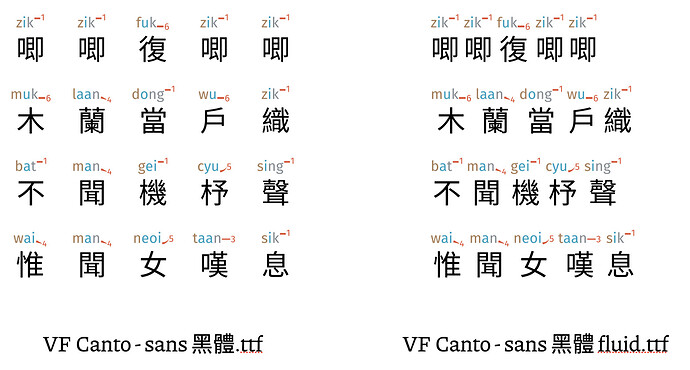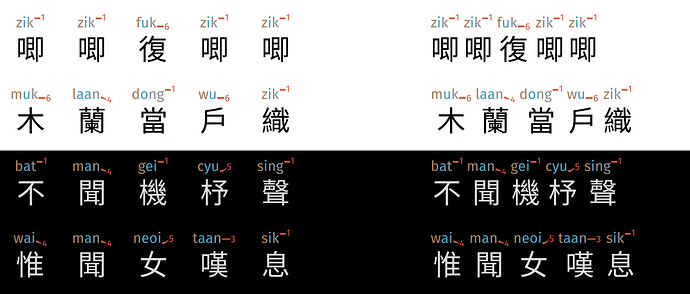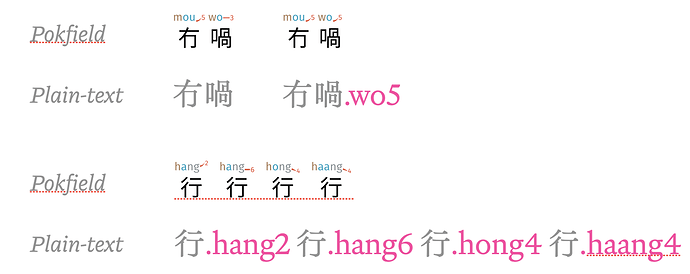This post is a high-level overview of features built into Canto Font v2 (code-named Pokfield). For specific tutorials or applications, see the Docs section of the forums.
C = Community Edition
E = Extended Edition
Font families
(C) includes the following choices of font installations.
- VF Cantonese.ttf (210 Mb) Characters in this file are 黑體 and fixed width. This is generally recommended, and referred to as the Standard Pokfield, and excels at poems and lyrics where equal spacing between characters is a must. In the rare cases when words with long jyutping next to one another (e.g., 硬
ngaang6or bi-syllabic characters), they will no longer remain fully fixed width, but characters gain a little breathing room to avoid clashes. - VF Canto - sans 黑體 fluid.ttf (210 Mb) Characters in this file are only as wide as their jyutping requires.
- VF Canto - sans 傳承宋體.ttf (210 Mb) A modification of Standard Pokfield, this fixed width font contains characters as heritage-style glyphs from I.Ming.
The following fonts are equivalent to the above, but without color information. This is useful for use on systems that do not support color fonts (e.g., Kindle and other monochrome eBook readers, some applications, Windows, and pre-2023 Linux distributions.)
- VF Canto - sans 黑體 - BW.ttf (30 Mb)
- VF Canto - sans 黑體 fluid - BW.ttf (30 Mb)
Extended Edition
The Extended Edition includes the following additional fonts:
- VF Canto - sans 黑體 - large jyutping.ttf The Jyutping in these are extra large, and is good for early learners. This lets them focus on the pronunciation while retaining some osmosis exposure to characters. This is only available in fluid-width since the fixed width introduces so much white-space as to be unreadable.
- VF Canto - sans 黑體 - small jyutping.ttf The Jyutping in these are smaller (equivalent to v1 jyutping sizes for our existing users), with the longest jyutping fitting over one characters.
- VF Canto - sans 黑體 - no jyutping.ttf This version has no jyutping but has otherwise the same metrics as the Standard Pokfield. This is very helpful for preparing material that places Jyutping selectively only over some characters.
- VF Canto - sans 黑體 - bold.ttf This is Standard Pokfield, with bolded Chinese characters.
When installed, these additional fonts can be found as variants (like Bold or Italics for normal fonts) under the same name of VF Cantonese in the font choice lists. The No-Jyutping variant is mapped as an “Italic” for applications, and Bolded variant is mapped as “Bold”, so in most applications they can be accessed with keyboard shortcuts ctrl/cmd-I and ctrl/cmd-B.
Glyphs content
Alphanumeric characters
All Pokfield fonts contains the full set of Latin, Greek, and Cyrillic alphanumeric glyphs (~1,000), and all CJK (Chinese-Japanese-Korean) punctuation in mid and ground levels. They do not contain vertical layout punctuation.
CJK characters
All Pokfield fonts contains > 28,000 characters, for a total of > 39,000 readings. This represents 100% of Cantonese-readable characters and 100% of their possible readings.
In the colored fonts, the Jyutping colors are fixed, while the color of the Chinese character can be changed in the external application. The Jyutping colors were carefully chosen to be readable on both light and dark screen background, as well as in colored and monochrome print. Note that color printing uses subtractive CMYK pigments, and the result will be somewhat less vibrant than when viewed on emissive RGB screen.
Smart Pronunciation
A core technical achievement in Pokfield is its ability to assess the environment that a character is surrounded by, and change the pronunciation to fit the occasion. The accuracy of Pokfield is unparalleled, and surpasses all but human experts. With standard modern prose (e.g., news articles), Pokfield benchmarks at 99.85% correct assignment, a 25-fold improvement over the previous state-of-the-art.
All Pokfield fonts are capable of recognizing > 60,000 contexts (in other words, all known contexts) and respond to them accordingly.
Accepts User Guidance
In the case that the font-suggested readings are not correct in that situation, the user can over-ride the suggestions manually. This is done with the following two mechanisms:
Word segmenting
In some cases, the incorrect suggestion comes from the font perceiving a different context than the user intended. For example, in the phrase 天上落雪, the font sees 上落 as one unit, and provides soeng5 as the pronunciation. The user can guide it by marking out the boundaries of words using the | pipe/bar symbol (often found above the Enter key). This | symbol is a private language for the user to interact with Pokfield invisible in the font and does not introduce any additional spacing issues.
Requesting one specific pronunciation
Cantonese pronunciations often cannot be inferred from the written script: 冇喎 can mean “but there is none” (when wo3 is uttered) or “I am skeptical that there is none” (when wo5 is uttered). There is nothing for Pokfield to use to infer a reading.
It is also possible that you, as the parent/teacher, wish to show-case a specific sound without providing a context (e.g., the multiple readings of one character).
In these cases, simply type a period .behind the character, followed by the jyutping you wish to see:
Since Pokfield supports all known ways to read every character, users can express even the rarest of usage:
Pokfield is truly flexible and provides full command for expressing the complexities of the language.
(Note that this . dot-syntax override require the font renderer to support mixed script ligatures (the instructions contain both Chinese, punctuation, and Latin scripts. This is available in Mac/CoreText and Win+Mac/VectorStyler.)
Features for Learners
English-Chinese Dictionary
The font has a built in “dictionary” with about 3,000 common words, and 1,000 proper nouns (countries, cities, Hong Kong locations). When these words are tagged by wrapping inside {} braces (e.g., {banana}), the term will automatically be translated to Chinese (with Jyutping). The matching occurs for all inflected forms of nouns, as well as all conjugated forms of the verbs contained.
This lets you explore the language on your own.
At some point, you may progress to reading Jyutping/Chinese texts, and find that you don’t know a Chinese word; the tag-to-translate feature can also goes from Chinese to English.
Feature for Teachers
Standalone tone marks
Standalone tone-marks can be accessed using the keyword tone. These matches up with the proportions of the Latin alphabet. You can use this to construct jyutping in the same style as it appears in the furigana.
If you wish to show your students the pronunciation of si in all six tones, like what is shown above, you can simply type
si{tone: 1} si{tone: 2} si{tone: 3} si{tone: 4} si{tone: 5} si{tone: 6}
To match the colors to what is found in the color font, you can use the following RGB hex-codes:
- onset:
AD 7F 58 - nucleus:
05 A2 C2 - coda:
88 90 96 - tone:
E5 4D 2E
These colors were carefully chosen to be readable on light as well as on dark backgrounds, reads well as monochrome print, and color-separates to use (almost) only CMY inks.[^ which have interesting implications for the future.]
Cultural images
Idioms library
There are over 1,000 idioms embedded into the font, written only in Traditional Chinese, and sorted by character difficulty. Using the idiom or 成語 keyword, teachers can quickly draw an idiom from the bank and use them as interesting conversation starters (“此地無銀 doesn’t just mean there’s no silver!”), or introduce cultural / historical aspects.
Cantonese Grammar
The following keywords are available to query Cantonese grammar:
{measure: n}gives a measure word (classifier). There are ~110 classifiers, with n=1–20 corresponding to the most frequently used.{measure: n ex}gives an example usage{measure: n ? }gives a brief explanation
More to come in the future.
Maps
Vocabulary collections
Broad Compatibility
Being “just a font”, what Pokfield offers hold true across most operating systems and applications, with the caveat that the platform implement the font standards correctly. Pokfield can be used not only on MacOS (Intel and ARM64), Windows, and Linux machines, but also devices like Kindle (and smart watch, and Apple Vision Pro, and…).
It can generally be used with applications that let you change the font. Our users have used this for their
- presentations,
- documents,
- spreadsheets,
- video subtitles,
- flash-cards,
- sheet music,
- graphic design,
- game creation,
and browsing the internet — which includes having all of your favorite Canto-pop lyrics while listening to Spotify, or Classics containing archaic characters that even native speakers needed to use a dictionary to read.
Longevity, Privacy, and Safety
Software and digital experiences are ephemeral on a human time-scale: unmaintained websites goes dark, and applications break just because you updated something else that shouldn’t be related. And of course, modern software all wants to be rented: you can use it as long as you pay the monthly extortion subscription.
Software and games also wants to siphon as much of your personal information to the highest bidder.
Then periodically some security holes open up, and you’re 0wn3d through no fault of yours, with little notification and no recourse.
Canto Font is just a font.
Canto Font is just a font, and fonts are extraordinarily durable: last year (2023) some people were upset because an Adobe update broke support for fonts they purchased in 1985. No subscriptions. Your Pokfield .ttfs can become family heirloom for your great-grand-child after the apocalypse hit.
Canto Font is just a font. It cannot phone home with your information, or what you wrote with it.
Canto Font is just a font. There is nothing to be hacked.
Canto Font is just a font, but it is as close to principled and perfect as we can get.






